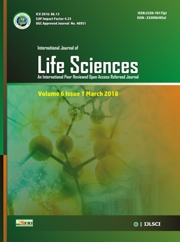RESEARCH ARTICLES
Volume 9 |Issue 4| July-August 2021 First published: 30 July 2021
Premarinal effect (estrogen) on pituitary gonadal axis in the fish, Clarias batrachus (L.)
Veena Mahajan
Assistant Professor & Head, Department of Zoology, J. M. Patel College Bhandara, Maharashtra, India
E-mail: mahajanveena2020@gmail.com
Abstract
Keywords:Estrogen, gonadotrophin, inducer, sex steroids and spawning reflexes.
Editor: Dr.Arvind Chavhan
Cite this article as:
Veena Mahajan. Premarinal effect (estrogen) on pituitary gonadal axis in the fish, Clarias batrachus (L.), Int. Res. Journal of Science & Engineering, 2021, Volume 9(4): 101-104.
References
1. Mananos, E., Duncan, N. and Mylonas, C. Reproduction and control of ovulation, spermiation and spawning in cultured fish. 3-8. In: cabrita E., Robles V., Herracz P. (eds): Methods in reproductive aquaculture. Marine and freshwater species. CRC, Press, Florida, 2009; Pp. 549.
2. Adams,B. A., Vickers, E. D., Warby, C., Park, M., Fisher, W. H., Grey, Craig A., Rivier, J. E. and Sherwood, N. M. Three forms of gonadotropin releasing hormone, including a novel form, in a basal salmonid Coregonus Clupeaformis. Biology of reproduction, 2002; 67, 232 – 239.
3. Kouril, J., Hamackova, J. and Barth, T. Harmonally induce artificial reproduction of fish. Biotechnology, Scientific pedagogical publishing, ceske Budejovice, Czech Republic, 2006; 251-253.
4. Kouril, J., Hamackova, J. and Barth, T. Harmonal induction of tench with the same treatments at two sequential reproductive season. Cybium, 2008; 32, 61.
5. Alok, D. Hussin, S., Kumar, R. S., Trant, J. M., Yu,K. and Zohar, Y. Charecterisation of a pituitary GnRH – receptor from a perciform fish, Morone Sexatilis; Functional Expression in a fish cell line. Mol. Cell. Endocrinol, 2000; 168, 65 – 75.
6. Arabaci,M., Cegirgan, H., Sari, M. Induction of ovulation in ornamental common carp (Koi, Cyprinus carpio L.) Using, LHRHa combined with haloperidol and carp pituitary.Aquaculture research, 2004; 35, 10 – 14.
7. Brown. P., Sivakumaran. K. P., Stossed. And Giles. A. Population biology of carp (Cyprinus Carpio L.) in the Mid – Muray River and Barmah Forest Wetlands, Australia. Marine and freshwater research, 2005; 56: 115 – 1164.
8. Davidson. Yu-Chung, Christopher Benjamin Rees., Mara Beth Bryanand, Weiming Li. Neurogenic and neuroendocrine effect of goldfish pheromone. The journal of neuroscience, Dec. 2008; 28 (53): 14492 – 14499.
9. Tempero, G.W., Nicholas Ling., Brendan J. Hicks and Matthew W. Osborne. Age composition, growth and reproduction of koi carp (Cyprinus carpio) in the lower Waikato region. New Zealand. Journal of marine and freshwater Research., 2006; Vol. 40: 571 – 583.
10. Finn Arne Weltzien., Eva Andersson., Ovivind Anderson., Kamran Shalchian- Tabrizi and Birgitla Norberg. The brain- pituitary-gonadal axis in male teleosts with special emphasis on flat fish. Camparative Biochemistry and Physiology part A. 2004; 137, 447-477.
11. Sivakumaran, K. P., Brown. P., Stoessel, D. and Giles, A. Maturation and reproductive biology of female wild carp. Cyprinus carpio, in Victoria, Australia. Enviornmental Biology of fishes , 2003; 68 : 321 – 332.
12. Sorensen, P. W. and Stacey, N. E. and Chamberlain, K. J. Differing behavioral and endocrinological effects of two female sex pheromones on male goldfish. Horn. Behav, 1989; 23 (3) : 217 – 32.
13. Chen, C. C. and Fernald, R. D. GnRH and GnRH receptors, distribution, function and evolution. Journal of fish biology, 2008 ; 73, 1099 – 1120.
14. Glasser, F., Mikolajczvk, T., Jalabert, B., Baroiller, J. F. and Breton, B. Temperature effect along the reproductive axis during spawning induction of grass carp. General and comparative endocrinology, 2004 ; 136, 171-179.
15. Hirose, K. Endocrine control of ovulation medeka Ayu. J. Fish. Res. Board. Can.,1976; 33, 989-994.
16. Long Yu, Lie skaojun, Huang weiren, Zhang Jian, Sun Yuandong, Zhangchan chen song,Lie Jinghui and Lie Yun. Camparative studies on histological and ultrastructure of the pituitary of different ploidy level fishes. Science in china series C; Life sciences, 2006; Vol. 49, No. 5, 446-453.
17. Mylonas, C. C. and Zohar, Y. Promoting oocyte maturation, ovulation and spawning in farmed fish, 437-474. In: Babin j. P., Cerda, J., Lubzens E. (eds).:The fish oocyte springer, The Netherlands, 2007; Pp. 510.
18. Peter, R. E. and Yu, K. L. Neuroendocrine regulation of ovulation in fishes: basic and applied aspects. Reviews in fish Biology and fisheries, 1997; 7, 173 – 197.
19. Podhorec, P. and Kouril, J. Induction of final oocyte maturation in cyprinidae fish by hypothalamic factors: a review. Veterinarni medicina, 2009; 54. (3) : 97 – 110.
20. Stacey,N. E. and Sorensen, P. W. Function and evolution of fish hormonal pheromones. In Biochemistry and molecular biology of fishes (P. W. Hochachka and T. P. Mommson, Eds) , 1991; Pp. 109 – 135. Elsevier / North. Holland, Amsterdam

